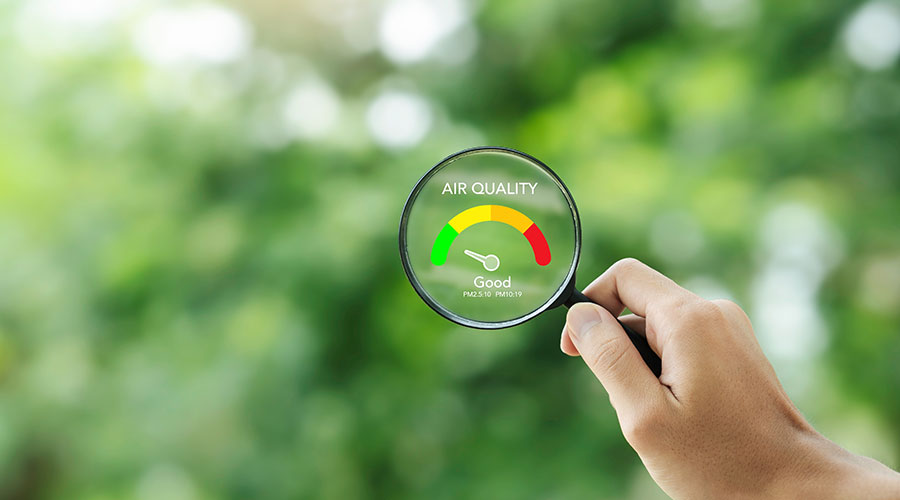Training Spotlight: IAQ and Technology
To select the ‘right’ training for diagnosing IAQ problems, managers must understand IAQ technology, facility operations and technician needs
Indoor air quality (IAQ) continues to rise on the priority list for maintenance and engineering departments. Both the general public and building occupants are more aware of potential IAQ problems in classrooms, office buildings and hospital patient rooms, and they are more likely to alert technicians about a potential problem.
To respond effectively to these calls, managers must ensure their front-line technicians receive both the proper training on troubleshooting and correcting IAQ problems and the right tools for the job.
Focus on Training
The newest generation of IAQ diagnostic monitoring technology is more complex than ever, and investing in these tools can be costly. For these reasons, training to use the equipment must be comprehensive and cost-effective. Among the questions managers must address when looking into training options for front-line technicians are these:
-
What role will equipment vendors play in providing training?
-
Will training take place at the job site or away from the workplace?
-
How will the department compensate for time spent in training when it comes to scheduling and work load?
-
What are the specific goals of the training sessions?
-
What role does training technology — the internet, CD-ROM,etc. — play in the selection process?
Any kind of training is better than no training at all, especially when it comes to high-tech systems and equipment. Even the more experienced technicians will not use technology they don’t understand.
To ensure a proper return on the investment in IAQ monitoring technology, managers also will need to spell out ahead of time all of the costs associated with the purchase, as well as exactly how the organization will benefit from the investment.
IAQ Technology
In order to implement effective training, both managers need to understand how technicians will use the tools and technology in the field to detect and prevent IAQ problems, as well as to respond to occupant complaints.
The latest generation of portable IAQ monitors allows technicians to measure a range of air characteristics, including carbon monoxide, carbon dioxide, relative humidity and temperature. The monitors also can record particle counts, measure volatile organic compounds, determine airflow, and measure differential pressure. Users can collect data and read it directly from the unit, or they can upload collected data to a computer for tracking and analysis.
Generally, there are five characteristics of air that are used to classify its quality: temperature, moisture, contaminants, light and noise. If managers and technicians can maintain these characteristics at tolerable levels, both building occupants and visitors will have a greater feeling of well-being, will be less stressed, and will have no adverse health effects related to the indoor environment.
But if technicians cannot keep these characteristics at tolerable levels, complaints can result that range from discomfort to illness, such as fever, headaches, lung problems and infection.
Monitoring Options
Addressing a reported problem as part of an IAQ program can be done using in-house resources, conferring with air-handling equipment suppliers, or using a testing lab. Technicians should maintain a log of reported problems, including the nature of the problem, who reported it, when, and the outdoor weather conditions at the time. Technicians should make sure to listen to individuals more sensitive to IAQ problems because the cumulative effects might generalize a problem that this person noticed first.
Monitors come in personal, portable and stationary varieties. The active types of monitors draw air into the sampler and perform real-time analysis. With passive types, the air diffuses into the sampler, so a long time is required for accurate results. Some units are classified as analyzers and provide an instantaneous readout, depending on the concentration. Other monitors are classified as collectors and gather a sample into a suitable medium for later analysis.
Personal monitors. These monitors are used to measure concentrations of inorganic gases, such as carbon dioxide (CO2), carbon monoxide (CO), nitrogen dioxide (NO2), and sulfur dioxide. One frequently used CO monitor measures 1,600 data points in 24 hours with automatic data logging. It continually draws air through a pump to a deionized water cell. The CO reacts with water, and an LED display shows the CO concentration.
Portable and stationary monitors. The four types of these samplers include: air displacement; condensation; gas washing, or absorption; and adsorption.
In the air-displacement method, a technicians collects an air sample in an evacuated flask or plastic bag. In the condensation method, the sample passes through a U-tube and cooled below the pollutant’s boiling point. Gas washing is done by bubbling the sample through an impinger, in which the sample dissolves or reacts with. Adsorption uses activated carbon, silica gel, molecular sieves or polymeric filters.
To select the proper IAQ monitoring technology, managers and technicians must know the building, its furnishing materials and other conditions that might contribute to IAQ problems, such as combustion and chemical reactions in a chemistry laboratory or outdoor pollutants present in the area.
One IAQ monitoring system on the market gives users the ability to monitor air-flow volume, CO, CO2, relative humidity, temperature, and pressure differential, and they can use it as either a continuous or spot monitor.
Gas analyzers for boiler rooms measure toxic gas levels, including carbon monoxide, nitric oxide, NO2, and sulfur dioxide. And leak detectors are available for detecting several refrigerant gases, such as R12, R22, and R502 with one instrument by changing the position of a switch.
In the end, the challenge for managers is to choose training that takes into account these essential factors — new IAQ technology, facility operations, and technician information needs.
IAQ Information and Resources
Information on training and education related to diagnosing and addressing indoor air quality issues is available from a range of organizations and associations. They include:
-
Air-Conditioning & Refrigeration Institute (ARI), www.ari.org, (703) 524-8800
-
Air Movement and Control Association International, www.amca.org, (847) 394-0150
-
ASHRAE Learning Institute, www.ashrae.org, (404) 636-8400
-
BOMI Institute, www.bomi-edu.org, (800) 235-BOMI
-
International Association of Plumbing and Mechanical Officials, www.iapmo.org, (909) 472-4100
-
National Electrical Manufacturers Association, www.nema.org, (703) 841-3200
-
Plumbing-Heating-Cooling Contractors–National Association, www.phccweb.org, (703) 237-8100
|
Related Topics:











